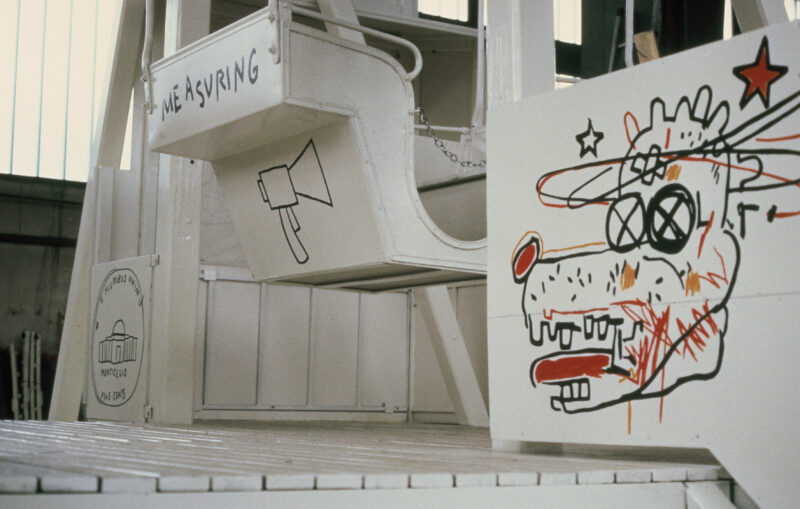
Jean-Michel Basquiat

For Luna Luna, Jean-Michel Basquiat designed a Ferris wheel on which recurrent subjects from his earlier work appear. The wheel was accompanied by Miles Davis’s 1986 song “Tutu.”
Artist
Jean-Michel Basquiat
Attraction
Painted Ferris wheel with music
Born
1960, USA
Basquiat started out as a graffiti artist, tagging downtown New York with SAMO as a teenager in the 1970s
He frequently drew and painted on found surfaces, including wood and even a refrigerator
His works combine figuration and writing to create compositions bursting with tantalizingly inconclusive meanings

Fairground view: Jean-Michel Basquiat, Painted Ferris wheel with music. Luna Luna, Hamburg, Germany, 1987.

One of the most significant artists of the twentieth century, Jean-Michel Basquiat began his short but prolific life as an artist painting the tag SAMO across downtown New York as a teenager in the late 1970s. Soon entrenched in the downtown cultural scene, he began to paint on canvas, creating compositions that combine numerous ideas, including a celebration of Black music and sports, an exploration of African American history, and critiques of abuses of power by the police.


The classic anatomical reference book Gray’s Anatomy was given to him as a child after he was hit by a car—the visuals from which inspired the exposed skeletons and internal organs of his figures.
Basquiat was a self-taught artist whose symbolic compositions combine colorful, naïve stick figures—ungrounded, without perspective, appearing as if floating in space—and cryptic, poetic words written in assertive capital letters, often repeated and crossed out, to push the viewer to think harder as they read. Music was hugely influential to Basquiat; he regularly attended Mudd Club and other countercultural venues, and also formed his own no wave band, Gray, titled after the classic anatomical reference book Gray’s Anatomy—a book given to him as a child after he was hit by a car, which partly inspired the exposed skeletons and internal organs of his figures.

Fairground view: Jean-Michel Basquiat, Painted Ferris wheel with music. Luna Luna, Hamburg, Germany, 1987.
For Luna Luna, Basquiat designed a Ferris wheel on which recurrent subjects from his earlier work appear, including jazz musician Charlie Parker (referenced with the song title “Billie’s Bounce”) and race (referenced with the words “Jim Crow,” followed by a copyright symbol that points at the relationship between the laws regulating the segregation of Black people in the South and the ownership of a human life). The wheel is accompanied by Miles Davis’s 1986 song “Tutu.” It was only after Heller secured permission to use the song that Basquiat agreed to create the Ferris wheel.

Fairground view: Jean-Michel Basquiat, Painted Ferris wheel with music. Luna Luna, Hamburg, Germany, 1987.

Fairground view: Jean-Michel Basquiat, Painted Ferris wheel with music. Luna Luna, Hamburg, Germany, 1987.
All Basquiat works © Estate of Jean-Michel Basquiat
Forgotten Fantasy
Thirty-six years ago, Luna Luna landed in Hamburg, Germany: the world’s first art amusement park with rides, games, and attractions by visionaries like Jean-Michel Basquiat, Keith Haring, and David Hockney. By a twist of fate, the park’s treasures were soon sealed in 44 shipping containers and forgotten in Texas—until now.